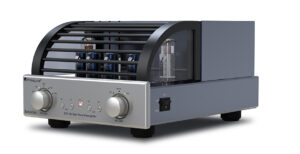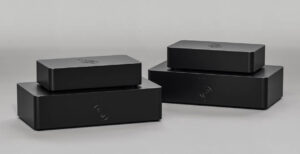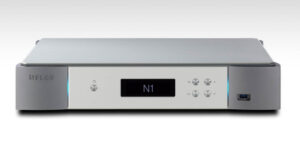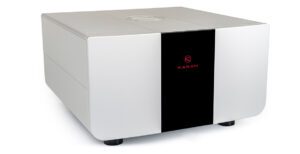
If you have watched a Formula 1 race anytime recently, you’ll have witnessed the strange phenomenon of the safety car in action, the undignified spectacle of one of the world’s most desirable sports cars – the Mercedes GT – looking decidedly plump and wallowy as it scrambles to stay ahead of a field of low, lithe, dartingly agile F1 cars, desperately trying to go slowly enough to stay behind it while the chorus of driver complaints rises and rises in volume. Comparing the Grand Prix Audio Parabolica to more conventional turntables, is to experience the same slightly bewildered sense of absolute superiority. With its sleek, compact chassis and no-nonsense, engineering-led aesthetic, the Grand Prix turntables don’t look or sound like the top-flight competition. At a time when ‘serious’ record players seemed to be the size and weight of a small chest of drawers loaded with concrete blocks, Grand Prix’s original Monaco was little bigger than the records it played and a mere five inches tall. Despite that and in a market where size apparently matters, it took on all comers and vanquished them. Just like the F1 cars its name brings to mind, its diminutive dimensions represented the ultimate distillation of pure performance, a shocking superiority to the run of the mill.
The latest Monaco v2.0 still sits at the top of the GPA tree, still taking on the over-weight and over-priced competition while gaining in engineering sophistication, performance, and price as the years have gone by – although it still represents a serious bargain compared to other high-end offerings. But at the same time, that increase in price has created the opportunity to offer a more affordable version of the company’s proprietary direct-drive technology and its elegant chassis. But there’s much, much more to this turntable than direct-drive and a bit of carbon-fibre. Like everything else in audio, it’s not what you use but how you use it that matters, and in the case of Grand Prix Audio, execution really is everything. The clue is in the name, both of the company and the product itself. Chief designer and engineer Alvin Lloyd was one of the founders of the all-conquering Swift Racing, a company that dominated CART racing in the US, as well as supplying chassis and engineering components to Formula One teams. In this case the Grand Prix moniker is more than just an affectation. That matters because it signifies both a pure performance background and a certain skill-set and experience. These days, making stuff from carbon-fibre isn’t difficult, with the one-time wonder material appearing on everything from iPhone cases to USB sticks. It’s a decorative trend that has undermined the engineering credibility of a material that has almost infinitely configurable properties – if you know what you are doing. Wrapping something in carbon cloth is one thing: Creating a complete component that is fully optimized to deliver specific mechanical and resonant performance attributes – that’s quite another. Enter then the Parabolica, GPA’s more affordable turntable, a product named for the fiendishly difficult curve that graces the Monza circuit, a name that reflects the significant challenge of down-pricing the Monaco without damagingly diluting its performance.

Outwardly the Parabolica is almost indistinguishable from its illustrious older brother: the same shallow platter, bowl shaped chassis and machined billet arm-board extension, the same minimal footprint, carbon finish, and three conical feet. Yet the Parabolica costs less than half the price of the Monaco while giving away astonishingly little in terms of measured or musical performance. Simply using carbon-fibre may not be that clever, but using it (as well as other materials) to achieve this? That’s very clever indeed!
Once you start to look more closely, you can see where the carefully chosen engineering compromises have been made. The Parabolica has a slightly fuller figure than the Monaco, allowing the computer control for GPA’s sophisticated feed-forward speed control system to be housed internally – saving the cost of the external box and cabling. The platter is machined from high-grade aluminium rather than magnesium with a phosphor-bronze flywheel and the feet are simple aluminium cones, although they retain the fine-thread levelling facility of the Apex composite footers supplied with the Monaco (an optional upgrade on the Parabolica). But the real clue lies in the relative weight of the two turntables. The Monaco might be small but at over 18 kilos it is astonishingly dense and inert. In contrast, the Parabolica weighs in at just under 13 kilos, still surprisingly solid, but reflecting the use of a braced carbon-fibre monocoque rather than the constrained layer, polymer damped chassis of the Monaco. Did someone say measurements? Using the 74,000 line encoder disc developed for the Monaco v2.0, together with system specific software matched to the same motor used in the original Monaco, GPA claim speed stability of 0.00011% RMS and peak deviation of less than 0.00015% for the Parabolica. That might not match the Monaco, which reputedly delivers a frankly astonishing further 0.000057% speed error and 0.00008% peak deviation, but it puts pretty much everything else in the shade. For example, the new Technics SL-1000R, which has been widely applauded for its remarkable speed stability, is quoted as delivering 0.015% RMS. I’m not going to get into competing claims and measurement protocols here, but you get the picture. There’s direct drive and then there’s direct drive: there’s speed stability and then there’s speed stability. But the best thing about the Parabolica’s measured performance is that it’s performance you can hear. Put simply, this turntable’s musical capabilities are as engaging as they are smack-you-in-the-face obvious.
Getting down to practicalities just for a moment, the Parabolica is more than just a carefully honed thoroughbred. In this day and age, where serious vinyl users often want to run more than one arm, the GPA’s minimalist dimensions, so effective when it comes to minimising airborne feedback, might put it at a disadvantage. Except that the armboard is precision located by a single, half turn Allen bolt, accessed via a threaded plug in the platter. Swapping pre-mounted arms takes a couple of minutes at most, whilst also maintaining exact geometry, with two additional, top mounted Allen bolts provided for ultimate security. A screw down clamp is provided, along with a range of three different polymer damping rings that fit over the spindle, corresponding to different weight records. A joy to assemble and set up, my one complaint about the Parabolica concerns the on/off switch – a capacitive pad underneath the front edge (one touch for 33, two for 45 and another to stop the deck). Like any touch sensitive control, it is less than positive and at first it is frustratingly easy to double tap it by accident – although you soon learn to use a swipe action that solves the problem. Maybe it’s just my Luddite tendencies and retro bent, but I prefer a nice, positive push-button. There again, there’s nothing retro about the Parabolica.
Listen to a system being fed by the Parabolica and you’ll hear musical poise, clarity, authority and vivid dynamics. What you won’t hear is the Parabolica itself. Unlike almost all other ‘tables it leaves a vanishingly small musical footprint, one that disappears behind the vagaries of recordings and associated equipment. One way or another, record players the world over act to blur, smudge, thicken, or gate the information stored in those vinyl grooves. They feed spurious energy back to the stylus (where it gets added to the signal), they suffer from speed variation (that softens the edges of notes and allows images to wander), and they introduce noise and vertical instability (that limit dynamic range). These are the signature traits of record replay that we have come to know and love – not least because as grievous as they are, they are still less musically intrusive than the vast majority of the alternatives. Until now! Listen to the Parabolica and it quickly becomes apparent that you are experiencing an analogue paradigm shift – one that places the performers and their performance front and centre, the mechanics of storing and retrieving that performance firmly in the background. This ‘table simply subtracts less from the signal and does less damage in the process.

The Argerich/Abbado recording of the Prokofiev 3rd Piano Concerto is a notoriously difficult disc. To hear it at its best you’ll need a phono-stage that offers Teldec EQ or the Speakers Corner 180g repressing. But you’ll also need a record player with the organisational talents, temporal stability, and dynamic and spatial clarity of the Parabolica. With all three options available, what so often descends into a cacophonous riot of jumbled notes was given shape, form, and control. Listening to the fluid, quicksilver playing, vividly dramatic colours, contrasts, and power of the solo instrument and it’s positioning against Abbado’s masterful marshalling of the BPO, it’s immediately apparent why the young Argerich exploded onto the international scene in such spectacular fashion. This performance isn’t just spectacular, it’s a technical and expressive tour de force, the Parabolica anchoring the tempo, the phrases, and the dynamic graduations without apparent effort and with no apparent limitation when it comes to headroom. Free of congestion and confusion, the result is as musically emphatic as it is purposeful, a performance that carries you along and leaves you drained at the final, shattering climax.
But the building blocks of this imposing performance are laid at the opposite end of the scale, the crisp, unforced clarity of Argerich’s Prokofiev echoed in the poised delicacy of Benedetti Michelangeli’s Beethoven, his astonishing grace and lightness of touch, the separation and relationship between his left and right hands, but most of all in their musical exchanges and conversation. This is a sense of musical organisation that extends beyond individual notes and phrases to the composition as a whole – and it’s maintained whether that piece involves one instrument, four, or a whole band. When it comes to recordings, the loud bits can hide a multitude of sins, yet with the Parabolica they don’t and don’t need to. It goes louder and does it with greater clarity than any belt driven or idler drive deck that I’ve used and if this is a direct drive trait, it’s a quality that also reflects the ability of a deck’s structure to cope with spurious energy, whether internal or external. The Parabolica’s excellence in this regard speaks volumes about the completeness and balance of its engineering solutions.
The acid test for any system or component comes with human voice, that most recognisable and subtly inflected of instruments and here the Parabolica reveals its true range. Playing familiar material, the way a singer uses their voice to shape a word or phrase is laid bare, engaging more directly, communicating more clearly. But what I wasn’t ready for was the expressive range the Parabolica revealed. On an album like Janis Ian’s Between The Lines [Columbia], her voice shifts between the fragile intimacy of ‘At Seventeen’ and the snarl of ‘Bright Lights…’, the deceptively open naiveté of ‘When The Party’s Over’, and the steely resolve of ‘Me To You’. It makes an already great album greater still, an effect I’ve experienced before, but only to this extent with GPA’s Monaco v2.0. What surprised (and delighted) me about the Parabolica was just how close it got to its bigger, older brother when it comes to musical expression. Which brings me I guess to the question of just how the two GPA ‘tables stack up? For once the answer is simple, both being cut from the same cloth. The strengths that are so apparent in the Parabolica – clarity, stability, organisation, and above all dynamic range – are taken a step further in the Monaco v2.0, meaning that its superiority is clear if you listen to the two decks side by side. But listen to the Parabolica in isolation and you’ll likely never know what you are missing. Just don’t listen to the Monaco unless you mean it…
In the same way that the Parabolica brings out the individuality and character in a performer, it does the same for matching tonearms. It’s not a fussy deck and its stable platform makes it applicable to any number of different partners: unipivot, gimbal, or linear tracking, it can be relied on to bring out the best in its matching arm, just as it reveals the musical core in different recordings. Most of my listening was with the Kuzma 4POINT/Lyra Etna combination, a pairing where the subtle dynamic and harmonic resolution of the cartridge dovetails perfectly with the power and stability of the arm and the authoritative platform provided by the deck. For me, the adjustable VTA facility of the arm is de rigeur,but for many listeners, I suspect that the Parabolica/4POINT9 combination, with its direct, lively sound, sense of musical intent and versatility when it comes to cartridge matching will represent the value sweet spot. It certainly offers an impressive mix of musical presence and rhythmic sophistication that gives music its own planted, positive, yet unforced pace and momentum. But either way, with a Kuzma or a different arm, it’s a mistake to see the direct drive Parabolica simply as a Monaco-lite or one trick pony. This is a beautifully balanced, agile and musically articulate performer; its pared back engineering is deeply reminiscent of the compact sophistication and purity of the Grand Prix heritage embedded in its DNA. There might be bigger or more comfortable decks; there are certainly those with more padding and (much) higher price tags, but for pure performance (and the purity of that performance) the Parabolica is awfully hard to beat.

TECHNICAL SPECIFICATIONS
Type: Direct Drive Turntable
Bearing: Factory sealed, hydro dynamic
Speeds: 33 and 45
Tonearm Mount: Precision located, quick release
Tonearm Compatibility: Universal – no restrictions on type or length
Weight: 12.5kg
Dimensions: 13” diameter plus armboard extension
Finishes: Gloss carbon chassis, painted finishes to order
Price: £16,500
Manufacturer: Grand Prix Audio
URL: grandprixaudio.com
UK Distributor: Definitive Audio
Tel.: +44 (0) 1159 733222
Tags: FEATURED
By Roy Gregory
More articles from this authorRead Next From Review
See all
PrimaLuna EVO 100 phono preamplifier
- Apr 22, 2024

Reiki Audio SuperSwitch Master Pro + Servant Pro
- Mar 27, 2024

Melco Audio N1-S38 music server
- Mar 27, 2024











